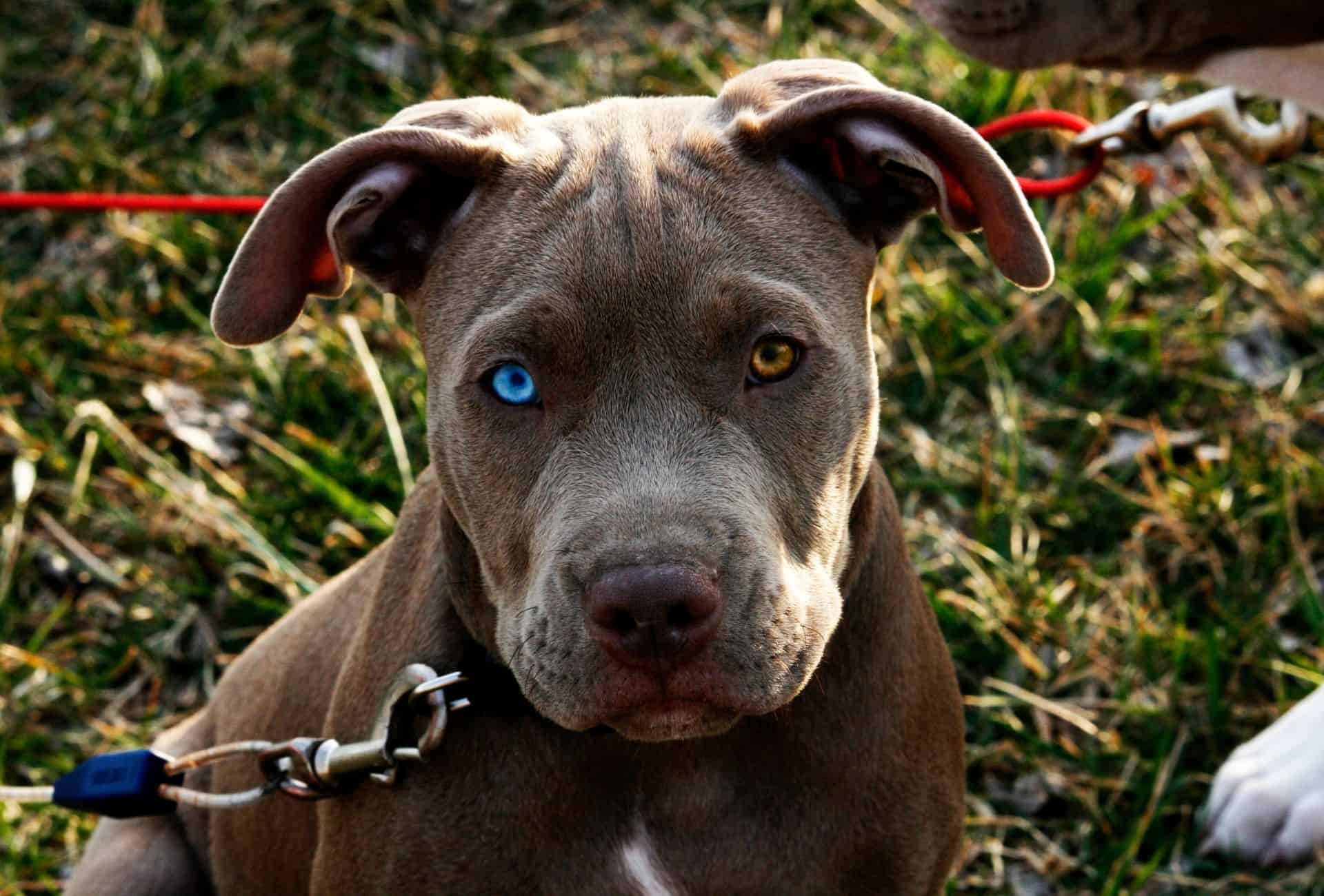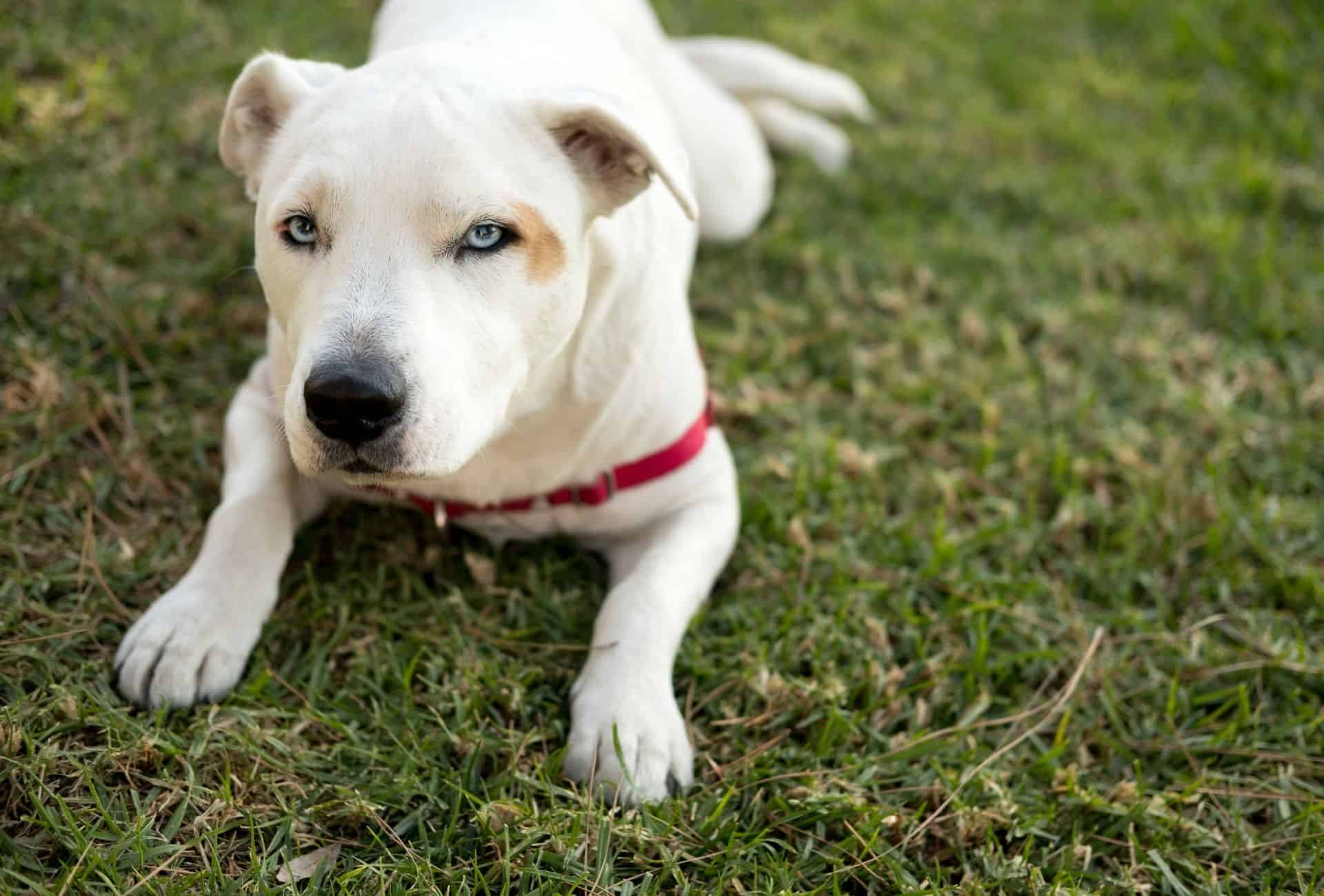Among white individuals, albinos are often found. Albinism refers to a lack of color pigment. These pit bull dogs have two characteristics: these dogs are blue-eyed and with light noses.
These individuals, despite their unique appearance, are recognized by the breeders as “wrong”, so they are not allowed to breed.
Often there are various color variations: from absolutely snow-white to grayish. The presence of a third color is possible – in the form of spots.
How Long Do Pitbull Puppy Eyes Stay Blue?
You may get a first glimpse at your Pitbull’s adult eye color around the age of 4 months.
Their puppy coat will be replaced by a much thicker and darker adult coat when they are 6 months old.
Blue-eyed Pitbull puppies are not rare and their eye color will most likely change over time.
So don’t choose the one bright-eyed Pitbull in the litter just because of his appearance.
Even if a breeder sells them as “rarity” for a premium, the color will almost certainly vanish (if it’s a purebred, more on that below).
That being said, while blue eyes are not particularly rare for Pitbull puppies, not every pup has blue eyes.
Check out my Cane Corso colors article for more information on how breeders try to falsely label colors.
Breeding for a specific color or coat type should always be a red flag when choosing a responsible breeder.
When specific looks are the primary breeding factor, other traits like temperament or health are disregarded.
You might find that the prettiest dog in a litter will have lots of health issues behind the facade.
Always make sure that the parents have health certificates and the right behavioral traits you are looking for.
Check out my article on questions to ask your breeder to avoid falling prey to these “breeders”.

Inbreeding in dogs is another huge issue and will be used to pass a certain appearance on to future generations.
As you might imagine, inbreeding comes with the worst health concerns and should never be encouraged.
Merle describes a beautiful coat color pattern that can create odd-colored eyes. It’s commonly seen in these breeds:
The merle gene sadly comes with many health issues like deafness and blindness.
Double merles (MM) are extremely prone to these genetic diseases and therefore merles should never be bred together.
Heterozygous merles (Mm) are way healthier and resemble the merle pattern best.
A Pit Bull with a merle coat pattern is excluded from the APBT breed standard and might not be purebred because the gene must have somehow found its way into the bloodline.
Tyrosinase is an enzyme that controls the production of melanin.
Albino dogs are “tyrosinase-negative” meaning that their body is incapable of producing melanin.
Therefore, these dogs will be born with a unique white coat, blue eyes and a pink nose.
Albinism in dogs is an extremely rare mutation and both parents need to carry the recessive gene.
Be very cautious when a breeder is trying to sell you a rare white pitbull.
Albinism comes with many health issues, including deafness or skin cancer.
Due to their pale coat, they must be protected from direct sunlight at all times using either bodysuits or sunscreen.

White patches around the eyes or nose can occur due to a lack of pigmentation.
Pit Bulls or any other breed with dominant white coats can develop light eyes or a pinkish nose.
Do Blue Eyed Dogs Go Blind?
Dogs with blue eyes are not necessarily doomed to develop any vision-related issues.
It largely depends on the specific reason your dog might have this eye color.
Pit Bulls are not among the breeds that carry this breed-specific gene, meaning that they probably will develop health problems later on.
You should stay away from the merle gene and albinism.
If you find a responsible breeder that has legitimate puppies with blue eyes, there is probably nothing you need to worry about as the color will start transforming at the age of 4 months.
Will My Pitbull’s Eyes Change Color When Growing Up?

As I have mentioned in the former section, your Pitbull’s blue eyes are not permanent. Unless, of course, they have a merle gene or they lack melanin.
When your pups are born, it takes 8 to 14 days before they can open their eyes and show you its diamond blue shade.
If you aren’t informed regarding this phenomenon, you will probably assume that they have rare eyes because there are no hints regarding their mature shade.
By the 9th to 12th week of your Pitbull, their permanent eye color will finally settle in. Note that this doesn’t happen overnight, so you will be able to witness the slow transformation of your Pitbull’s eyes.
It is quite possible to own a blue-eyed Pitbull without any health issues. However, some may have an increased chance of inheriting specific health problems from their parents and acquiring diseases throughout their lives.
Here are some health issues that blue-eyed Pitbulls can get afflicted with:
Because of having blue eyes, some dogs, including Pitbulls, may develop vision defects. This is due to the presence of the merle gene that dilutes the eye pigmentation.
Not all of those who have merle genes will automatically be afflicted with this problem—only those pups whose parents are both carriers of merle genes.
Deafness is another medical problem that can affect some Pitbulls with blue eyes. This is still linked to the merle gene’s presence but is also associated with the Piebald gene, which causes a lack of mature melanin-producing cells or melanocytes.
To ensure that your blue-eyed pup doesn’t have a hearing impairment, you can have him checked through BAER testing.
Eye diseases such as cataracts and glaucoma are often found in blue-eyed pups. If you noticed that your Pitbull’s eyes are turning cloudy, better have him checked by a trusted veterinarian. He may suggest eye drops to protect and hydrate your dog’s eyes.
FAQ
Are blue eyed pitbulls rare?
Is it common for pitbulls to have blue eyes?
Are all white pitbulls rare?